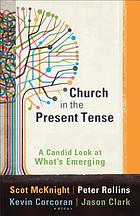 The Church in the Present Tense
The Church in the Present Tense
By Kevin Corcoran, Scot McKnight, Peter Rollins, & Jason Clark
Grand Rapids, MI: Brazos, 2011.
Guest Post by Rev. Cameron West.
The book delivers, however, on what it promises in the subtitle: “a candid look at what’s emerging”. This represents both the strengths and weaknesses of the book, too: we have a glimpse of a conversation still in progress, yet the quality of the contributions varies at points, and there is very little resolution.
Perhaps such weaknesses and limitations are inherent in this kind of multi-author work; in any case the book would have been strengthened by either of two features. Firstly, some kind of preface (am I the only person that still reads these?) proposing a raison d’etre for the book: how did it come about and what does it hope to achieve? Secondly, an opportunity for the authors to respond to each other, addressing some of the frequent divergences or even outright contradictions.
Each of the four parts of the book – philosophy, theology, worship, and Bible and doctrine – is comprised by two chapters, and apart from the last which is penned solely by Scot McKnight, the two chapters are by different authors. And, while each of the parts certainly contains something worthwhile – sensible insights from Kevin Corcoran, subversive lyricism from Pete Rollins and solid but refreshing orthodoxy from McKnight – the chapters by Jason Clark contained (for me, at least) the stand-out contributions of the book. In the first (chapter 3) he provides a compelling account of the challenges that consumerism poses to Christian formation in community, in the second (chapter 5) he proposes a response. Perhaps this merely demonstrates my bias and an underdevelopment in my own discipleship: I feel competent (and I use that word consciously) in reading the Scriptures, in discussing philosophy and debating doctrine. I feel at a near total loss, however, in bringing these to bear on the most dominant aspect of the contemporary context – namely the fetishisation of production, consumption and distribution, or, more bluntly, the idolatry of the Market.
Clark’s critique of consumerism as a “perverted” counter-liturgy is challenging for its brilliance. He makes the familiar claim that the process of commodification has eroded identity, transforming it from something that is (at least, partly) received as gift, into something that is (almost entirely) produced or purchased, and so, may be exchanged or discarded arbitrarily. But, stingingly, this then is applied to the collective identity of the people of God, that is, ecclesiology. Most jarring to me, was his reflection that “those able to maintain their own faith [after having discarded ‘church’] can only do so because of years of past training they had in church communities,” because it echoes but also takes issue with the claim of Jamieson (in A Churchless Faith and others) that outgrowing church is often given without irony as a legitimate reason for leaving it.
Least satisfying was the book’s opening chapter, in which Corcoran rejects the Emerging rejection of realism. It suffers from two significant faults: firstly, he provides no examples of emergent practitioners let alone theorists who sign up for the strong antirealism he dissembles; secondly, neither does he distinguish his ‘chastened realism’ from, for example, Wright’s ‘critical realism’ or Vanhoozer’s ‘hermeneutic realism’. In fact the determinative characteristic of chastened realism seems to be that, it isn’t really realism after all. Yes, Corcoran says, things really exist; I concur, and believe that Burke and Rollins would, too. But, he concedes our knowledge of things is “partial, incomplete, and fragmentary,” (p11, italics original). Yet, still he dismisses as ‘social-constructive anti-realism’ the claim, which would seem to be inherent in the above quote, that we cannot “know [a thing] as it is, apart from us.” So then, I was left wondering if there remained any distance on the anti-/realist spectrum between soft (chastened) versions of Corcoran’s realism and Rollins’ anti-realism.
Between these high and low points, the book offers entry into many other discussions – another take, this time from Rollins, on overcoming the gap between belief and behaviour, and McKnight out-gospelling The Gospel Coalition, for example. And as much fun as it would have been to comment on these and other chapters, one last observation is more necessary. It seems the book has made people tense because the authors are all white, male and even straight. Apart from observing that Australians and military chaplains were not represented (but now, thanks to this review, are) I note how heartened I am by Corcoran’s response (here). Yes, he concedes the point rightly made. More than that, I take his mea culpa as a concrete demonstration of intellectual discipleship that keeps the discussion moving so that it can remain open to other voices – even mine. Bravo.










